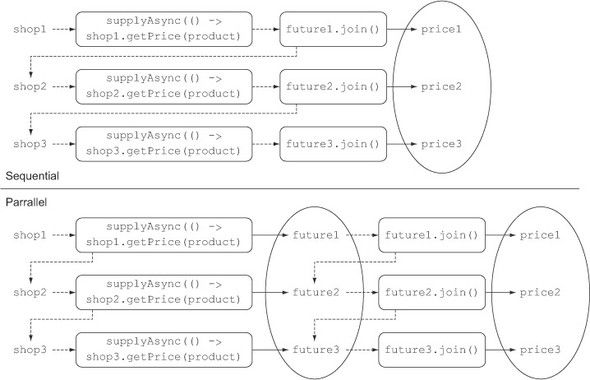Lambda表达式
一、lambda语法
参数列表 lambda body部分
(o1,o2)->o1.getWeight().compareTo(o2.getWeight());
二、 合法lamdba表达式
1、s -> s.length(); 或者 (String s) -> s.length();
2、apple -> apple.getColor().equals("great"); 或者 (Apple apple) -> apple.getColor().equals("great");
3、(int x, int y) -> {
System.out.println(x);
System.out.println(y);
};
4、() -> 12;
5、()-{};
6、()->“hello” 或者 ()->{return "hello"}
三、语法总结
语法一、(参数列表) -> 表达式
语法二、(参数列表) -> {语句;}
有效lambda表达式
1、() -> {}
2、() -> "hello" 或者 ()->{reurn "hello"}
3、(String str) -> {return "hello"} 或者 (String str) -> "hello";
无效lambda表达式
(integer i)->{return "错误示范"+i}
四、代码说明
package com.example.study.java8.InterfaceFunction;
import java.util.Arrays;
import java.util.Comparator;
import java.util.List;
import java.util.concurrent.Callable;
import java.util.function.Function;
import java.util.function.Predicate;
/**
* lambda语法
*/
public class LambdaExpression {
public static void main(String[] args) {
Comparator<Apple> colorComparator = new Comparator<Apple>() {
@Override
public int compare(Apple o1, Apple o2) {
return o1.getColor().compareTo(o2.getColor());
}
};
List<Apple> apples = Arrays.asList(new Apple("a", 18), new Apple("c", 20), new Apple("b", 10));
for (Apple a : apples) {
System.out.println(a.toString());
}
System.out.println("=================================");
apples.sort(colorComparator);
for (Apple a : apples) {
System.out.println(a.toString());
}
System.out.println("=================================");
//lambda expression
//方法推导:接口有返回值时,注意lambda有大括号{},必须要有return,没有可以不用使用return关键词
//1、有{},必须使用return
Comparator<Apple> weightComparator = (o1, o2) -> {
return o1.getWeight().compareTo(o2.getWeight());
};
//2、不使用{},没有return
Comparator<Apple> weightComparator2 = (o1, o2) -> o1.getWeight().compareTo(o2.getWeight());
apples.sort(weightComparator);
for (Apple a : apples) {
System.out.println(a.toString());
}
//合法lambda表达式格式1
Function<String, Integer> stringIntegerFunction = s -> s.length();
//合法lambda表达式格式2
Predicate<Apple> great = (Apple apple) -> apple.getColor().equals("great");
Predicate<Apple> great2 = apple -> apple.getColor().equals("great");
//合法lambda表达式格式3
// (int x, int y) -> {
// System.out.println(x);
// System.out.println(y);
// };
//合法lambda表达式格式4
Callable<Integer> integerCallable = () -> 12;
//合法lambda表达式格式5
Runnable runnable = () -> {
};
//合法lambda表达式格式6
Callable<String> stringCallable = () -> "hello";
//合法lambda表达式格式7
Function<String, String> stringStringFunction = (String str) -> {
return "hello";
};
//合法lambda表达式格式8
Function<String, String> stringStringFunction1 = (String str) -> "hello";
}
}五、学习目标
熟悉lambda语法后,主要学习:function、stream。
java.util.function、java.util.stream包下接口用法
六、Function学习
java.util.function包下主要的4中lambda接口用法以及扩展用户
1、Function有返回值
@FunctionalInterface
public interface Function<T, R> {
/**
* Applies this function to the given argument.
*
* @param t the function argument
* @return the function result
*/
R apply(T t);范例:
//Funcation有返回参数类型
//1、返回Boolean类型
Function<Apple, Boolean> boolearnFunction = apple -> apple.getColor().equals("red");
//2、返回String类型
Function<Apple, String> stringFunction = apple -> apple.getColor();
//3、返回Integer类型
Function<Apple, Integer> integerFunction = apple -> apple.getWeight();
//4、。。。等等其它类型同理2、无返回值
@FunctionalInterface
public interface Consumer<T> {
/**
* Performs this operation on the given argument.
*
* @param t the input argument
*/
void accept(T t);范例:
//Consumer无参数返回类型
Consumer<Apple> appleConsumer = apple -> System.out.println(apple.getColor());
Consumer<Apple> appleConsumer2 = apple -> System.out.println("hello");3、返回Boolean类型
@FunctionalInterface
public interface Predicate<T> {
/**
* Evaluates this predicate on the given argument.
*
* @param t the input argument
* @return {@code true} if the input argument matches the predicate,
* otherwise {@code false}
*/
boolean test(T t);范例:
//Predicate返回Boolean类型(判断类型)
Predicate<Apple> colorPredicate = apple -> apple.getColor().equals("red");
Predicate<Apple> weightPredicate = apple -> apple.getWeight()==4;4、获取对象
@FunctionalInterface
public interface Supplier<T> {
/**
* Gets a result.
*
* @return a result
*/
T get();
}get();
}
范例:
//Supplier获取对象
Supplier<Apple> appleSupplier = Apple::new;根据上面3种接口,返回不同参数类型,在不同地方选择使用。
七、那些是FunctionInterface(函数式接口)
1、除了default、static的方法外,只有一个方法的接口,就是funcationInteface
@FunctionalInterface
interface Adder{
int add(int a, int b);
}2、没有方法,但继承了有一个方法的接口是funcationInterface
@FunctionalInterface
interface Empty extends Adder{
}不是函数式接口的
1、继承后不止一个方法,因此不是funcationInterface
interface SmartAdder extends Adder{
int add(Long a, Long b);
}2、没有任何方法的接口,不是funcationInterface
interface DoNothing{
}





评论 (0)